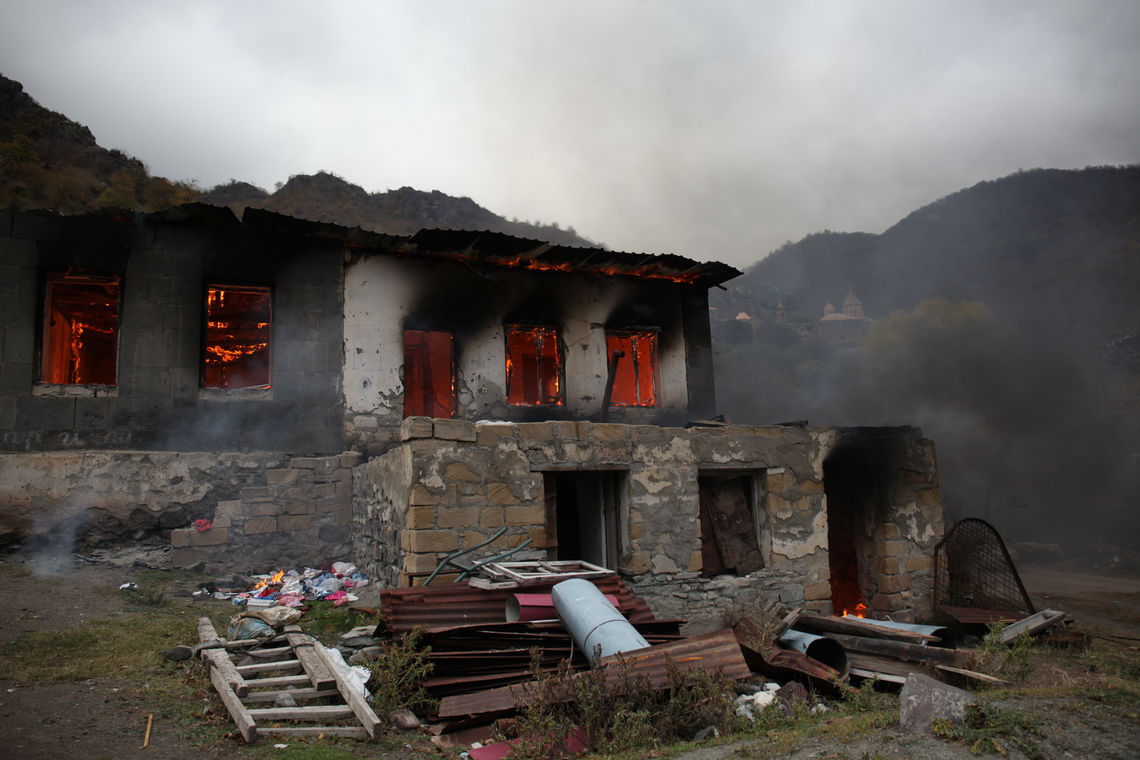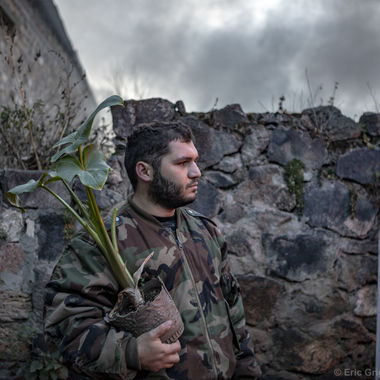
There are too many international reports covering stories of Armenian villagers setting their houses on fire in the Karvajar region of Nagorno-Karabakh, which will soon be handed over to Azerbaijan in the aftermath of a six-week war. “Ethnic Armenian villagers burn houses before Azerbaijan takeover” reads the headline of a video report by BBC News. After 44 days of often reluctant and one-sided reporting of this war and amidst the grey horror of cluster bombed homes, the red flames of Karvajar’s houses instantly made it to Reuters, BBC, Al Jazeera and people’s hearts. Friends, who had found no words for us during 44 long days, started reaching out. The story of burning homes had touched them. The images and video footage are truly heartbreaking. Except, the emotional response that these images elicit are somewhat misplaced.
The visual and narrative appeal of these stories is compressed in a recognizable human tragedy – a man wiping away his tears in front of his burning home. Viewers approach this story with horror, but not the type provoked by war in another country. Rather, audiences are invited to look at these images through a distant familiarity with human suffering during disasters. It is through a generic kind of shock that audiences connect with these stories. The war in Nagorno-Karabakh, however, failed to shock many. The burning Armenian homes beacon our attention with the human drama that they entail. War, on the other hand, is divested of drama. Images of war are gruesome, hard to look at. While there is nothing wrong with looking away from something that brings you pain, we must be aware that the human drama unfolding in the flames of these houses is the consequence of a war the world had chosen to look away from.
During the 2020 Artsakh War, multiple reports of bombed houses, schools, churches and hospitals emerged, but none of them garnered such consistent attention and narrative. Images of both burning homes and those demolished by cluster munitions equally document loss and displacement. Our lack of response to the former stems from the familiarity they offer. We have seen this in other wars. But burning your own home before leaving it is unthinkable. “How desperate must one be to set his own home ablaze?” We are perplexed. We cannot recognize this kind of suffering.
Photographs of homes destroyed by war, on the other hand, do not disturb us in the same way. They somberly state: “This is what war does” and reify our sense of comfort in not being there. Images of demolished homes from war-torn places are too commonplace and hard to tell apart (to the point that Azerbaijani social media spread numerous images from the Syrian war in their disinformation campaign over the past few weeks). In an era of overwhelming content, the action that images of bombed houses invoke is to move past them. Most of us cannot interact with the idea of yet another war happening somewhere in the world for longer than what it takes to react with an emoji to a social media post. The paradox of war photography baffles me: taken amidst death to move us—emotionally and physically—such images produce inactive compassion. If we lift a finger, it is to scroll past them. We consume images of a faraway war with a resigned acceptance: this is the consequence of any war.
It is not the outcome of the Artsakh war that these stories invite us to look at with shocked eyes, but rather the despair of people grappling with the aftermath of a little known war. In her book Regarding the Pain of Others, Susan Sontag suggests that Virginia Woolf’s reflections on photographs from the Spanish Civil War only confirm a “general abhorrence of war” that disengages from the history and politics of Spain as a country. By the same token, Karvajar stories invite audiences to look at the tragedy of Armenians burning down their own homes while simultaneously accommodating a selective empathy that dismisses the politics and history of this war. While the empathy of the reader remains within the limits of the catastrophe of burning houses, the flames of Karvajar extend beyond the six-week war. The displacement of Armenians from the Karvajar region is an extension of the historical loss of indigenous Armenian lands to the same autocratic powers.
Much like the de facto independent Republic of Artsakh, the struggle of its people goes unrecognized. The story of their fight for the right to exist in their ancestral homeland is consumed by the flames of these burning homes. Parallel to Sontag’s observation that a photograph is “not supposed to repair our ignorance about the history and causes of the suffering it picks out and frames,” we cannot expect a 500-word article to fill the knowledge gaps about the struggle of unrecognized people. But, what these stories should encourage us to ask is what and who have really ignited these homes?
see also
Lives Undone
By Eric Grigorian
In Artsakh, there is a somber air of loss, uncertainty and grief. During 45 days of war, everyone and everything from soldiers to villagers, trees to structures were afflicted and irreversibly altered. A collection of images from November 12-14, a few days after the "peace" agreement.
podcast
As the Kashatagh region of Artsakh is scheduled to be handed over to Azerbaijan by December 1, people bid their farewell to centuries-old Armenian religious monuments.





